Paska Easter Bread Recipe – Kulich
The Easter Bread recipe is just what you need this upcoming Easter. It is made of very flavorful, moist, buttery, lightly sweetened brioche that’s studded with beautiful morsels of white chocolate and rum-soaked dried berries. You can eat it as is with coffee or tea for breakfast or use it for the best-tasting French toast.
A mix between Italian Panettone and French Brioche, this Paska is a traditional Easter Bread of many Slavic countries. I hope you try it and love this delicious Easter tradition, just like our family has!
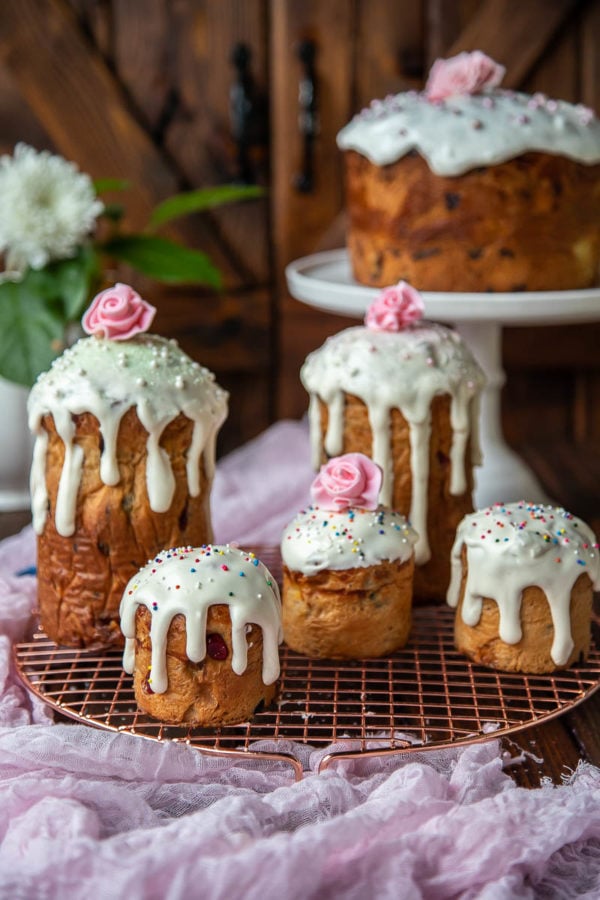
This Easter Bread can be baked in many sizes, from minis to medium-sized to a large and beautiful cake-like Paska.
Over the last couple of weeks, I have taken the time to test and perfect this recipe until I got exactly what I wanted and exactly what this traditional Russian Paska recipe should be. If you follow my Instagram, you’ve seen it for yourself. If you don’t, you can still check it out in the story Highlights.
What is Paska?
Many Ukrainians and other Eastern Europeans call Paska their Easter Bread. In Russia, they call it Kulich. Typical Paska Easter Bread is made with eggs, flour, sugar, and lots of butter and is similar to Italian Panettone. When this dessert bread is made properly, it will be light and fluffy but still somewhat moist.
There are many recipes for Paska, but one requirement is that the bread be tall. To achieve this height, Ukrainians use tall-lined coffee cans or smaller cans to bake tall Paskas. Then, the bread is topped with a thick white powdered sugar glaze and sprinkled with sprinkles.
The Perfect Easter Bread
Not many people have the time to test the recipe dozens of times to ensure it’s perfect, but I have! I’m super excited for you to try this truly amazing Paska recipe since it is indeed perfect. This Easter Bread is made with lots of butter, which keeps the bread from going hard and stale for more than a week!
Soaking the dried fruits for several days before using them in the Easter Bread allows them to plump up and fill with rum or water. Once they’re baked in the bread, they continue to give off moisture, preventing the bread itself from drying out.
This Easter Bread uses a basic brioche bread recipe which I posted about HERE. Go on and read all the tips and tricks on how to get the best results when working with enriched yeast dough.
Can this dough be used for Hot Cross Buns?
Sure thing! Divide the dough into 12 round balls and bake in a 9″x 12″ baking pan. After the buns cool, use the powdered sugar glaze from the recipe to pipe the cross pattern on top of them.
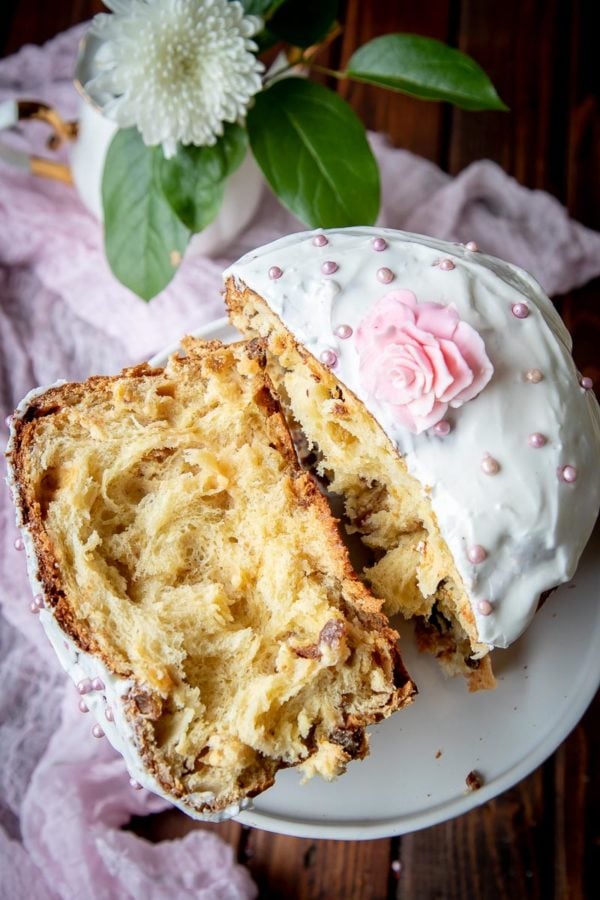
This Paska bread is made with golden raisins, dried sultans and white chocolate. The yellow flesh of the Easter bread is due to all the egg yolks in the recipe. The more yellow the egg yolks, the more yellow the bread.
Bread Maker Easter Bread
Among my trial runs there was a batch made in the bread maker as well. It’s definitely possible to just load up the ingredients, mix in the butter and salt in the later stages, and lastly, add the dried fruits and chocolate (I describe the method in the Brioche Bread post).
However, removing the bread from the bread maker immediately after baking can cause it to lose its perfect shape since the dough is extremely delicate. The flavor is all there, so it’s only the aesthetics that suffer.
If you were to make it in the bread maker, use the “white bread” 1.5-hour setting for a 2 lb loaf. Do not use the quick bread setting for this recipe.
The bread maker is best for mixing the Paska dough, though, so if you have one, use it to knead the dough! Read about how I use the bread maker in the post about making Brioche Dough.
Tips for Success:
- Make sure your yeast is active before starting. Starting with old or inactive yeast will not produce the needed rise for light and fluffy Paska. If you can, use Platinum yeast. It’s very forgiving and gives the best rise in baked goods.
- Soak your dried fruits well in advance. The fruits that I soaked a week in advance were a lot better hydrated and softer in the bread than the ones I soaked only 1 hour before starting or the ones that were not soaked at all.
- If possible, use European butter. European butter has a higher butterfat content, enhancing the bread with better butter flavor. If not available, don’t fret—use the butter you typically buy.
- Bake in tall paper molds for superior results. This Easter bread uses a very high-hydration dough. This means that when it comes out of the oven, it is very, very tender and soft. When you bake it in a metal pan, you need to unmold the bread immediately to prevent sogginess. Doing this can cause the bread to lean to the side or collapse from the weight of the tallness (is that a word?) of the bread.
When you bake the Easter Bread in a paper mold, it allows the bread to cool down in the mold, keeping the structural integrity of the bread without getting soggy. This is more important if you want to bake a tall Paska than if you bake the minis.
Substitute for Sprinkles
In place of sprinkles, you can use these White Chocolate Crispearls. They have a rice crispies type of center, coated in good quality white chocolate. They are sold in plain white chocolate color. Use any color of edible pearl dust to color them preferred color.
If you’re wondering how you can color the little white chocolate beads, it is super easy. Just add the crispiearls to a small container, then sprinkle some of the pearl dust over them. Next, shake it around until the crispearls are all coated.
FAQ – Why is my easter bread dough too runny? Should I add more flour?
- Low protein/gluten content flour: If your flour doesn’t have a high enough gluten content your dough might look runny or take longer kneading to get to a point where it looks like it should.
If your dough still resembles batter after kneading for 20 minutes, add up to 1/2 cup more flour 1 tablespoon at a time. If it still doesn’t come together into a stretchy dough, do not worry just leave it to proof as is. It will firm up in the fridge during proofing, making it easier to shape, and the Easter bread will be fine in the end.
- Butter too warm, or room temperature too warm: If the butter is too soft when added to the dough, or if the house temperature is very high, the dough can be on the runny side as well. Just proof and refrigerate the dough as is, though; do not add more flour.
Even when adding cold but malleable butter like the recipe requires, the dough is still on the softer/runnier side, but if your butter is too warm, it will be even more so.
Slack dough is not a problem if you plan to refrigerate it (best practice). Once refrigerated, the dough will firm up considerably and be much easier to work with. So, trust the recipe, place your runny dough in the fridge, and it will be okay.
If you don’t have the time for refrigeration, just allow the dough to proof until doubled in size as is (runny), then use very oiled hands to help you shape the dough and place it into the molds. If you do not oil your hands, you will have a sticky mess.
Why my Easter Bread is not rising?
This Easter bread recipe is highly enriched with butter, eggs, and sugar. All this weighs the dough down, and it can take a while for the dough to rise. A slower rising process should be expected with this kind of dough. But if it’s been hours and the dough is not moving, check out my troubleshooting tips below.
- Old yeast: If your yeast is expired or you’ve had it for a while, it might not be as active as recently purchased yeast. If your dough is rising even a little bit, give it extra time and keep the dough in a warm place until it doubles in size, even if it takes you 10 hours.
Optimally, though, you want to use good, unexpired, recently purchased yeast for a faster-rising process.
- Cold temps: If your house temperature is on the cooler side, the dough might also take a while to rise. To aid the proofing process, preheat the oven to 200F or 250F for a couple of minutes, then turn it off, turn on the oven light, and place your bowl with the dough in there. Make sure the oven is not hot, or it will kill your yeast, and it won’t rise at all. The temperature should be between 90F and 100F.
Ingredients for the Easter Bread:
This recipe uses typical Brioche Bread ingredients, such as eggs, butter, flour, sugar, and yeast. If using add-ins, choose your favorite dried fruits and decide if you want to use just one kind or several.
Traditionally, Paska is made with raisins, but I add white chocolate chips for extra sweetness and flavor, as well as dried cranberries, dried blueberries, and orange zest.
How to make Easter Bread:
- Start by pre-soaking the dried fruits. You can do this up to a couple of weeks or months in advance. Then, drain and paper towel dry.
- Start by making the brioche dough. Add all wet ingredients, including sugar, and top with flour and yeast. Knead until smooth and elastic, then add butter and salt and knead those in, too.
- Lastly, add the dried fruits and knead them in. For best results, cover and refrigerate the dough for at least 4 hours or up to 2 days. The dough will proof/rise slightly but not too much.
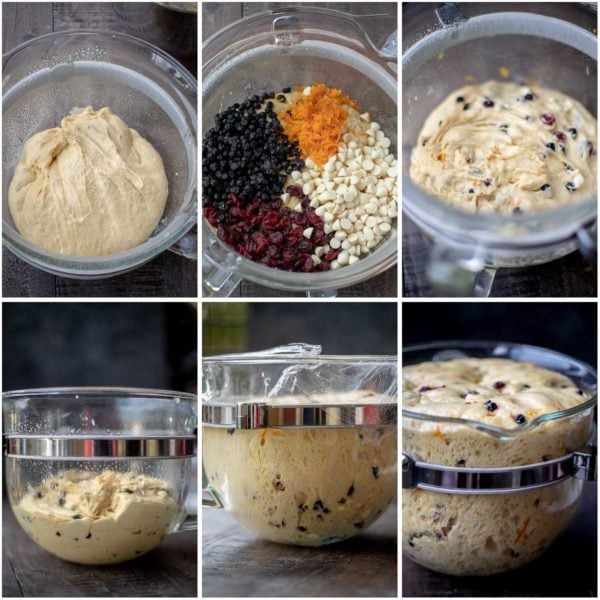
The pictures are from a doubled batch of Easter Bread.
- Remove the dough from the fridge, shape it, and place it into molds. If using cans for molds, line them with parchment paper. The molds should be filled halfway with dough. Once doubled in size, brush the tops with egg yolks.
- Molds to use: Choose one option for 1 portion of the dough
- One 7.5-inch mold
- Two 5-inch round molds
- or three 30 oz cans with both bottom and top removed, then lined with parchment paper.
- Molds to use: Choose one option for 1 portion of the dough
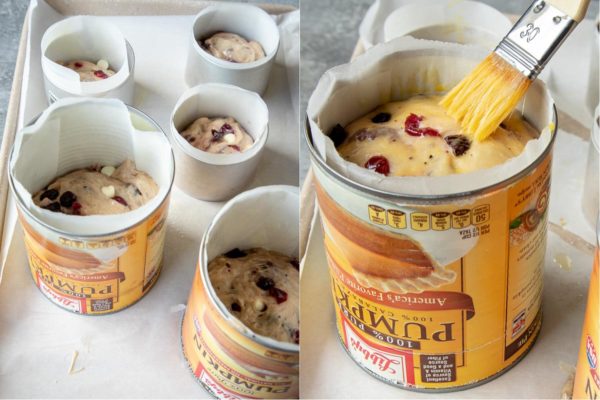
To use cans for molds: with a can opener, cut off the top and bottom. Line the cans with parchment paper and place them on a parchment-lined baking sheet, spacing them apart to promote even baking.
- You can spray the inside of the paper/carton molds with nonstick spray for easier removal of the Easter Bread.
- Once baked, allow to cool completely. If you baked in the cans, remove them from the can immediately and allow them to cool on a rack.
- While the bread is cooling, make the powdered sugar glaze / Royal Icing glaze.
- Then, dip the top of each Paka into the whipped powdered sugar and sprinkle with sprinkles right away. If you wish to have drizzles, fill a pastry bag and draw them out by going up and down where you want them.
How to Store the Paska Easter Bread?
You can store the Easter Bread under a cake dome or in a closed container to prevent drying out. You can also freeze it, wrapping it tightly with plastic for up to a month. If freezing, do not top it with glaze until after defrosting.
What to make with leftover Easter Bread?
Use the Easter bread to make this delicious French Toast Casserole (use Easter Bread instead of Poppy Seed pastries).
Are you looking for more Easter Recipes? Try these:
- Blueberry White Chocolate Bread Wreath – it makes bomb toast!
- Olivier Salad – we make this Russian Potato salad for every major holiday
Paska Easter Bread Recipe (Kulich)
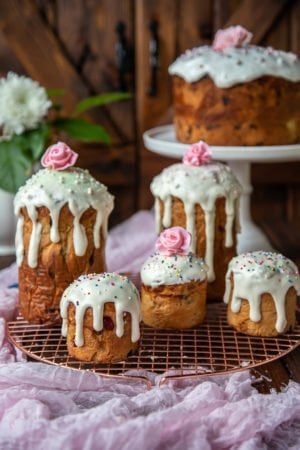
Paska Easter Bread is a sweetened buttery bread filled with lots of rum soaked raisins and white chocolate. Traditionally it is eaten on Easter, but can be made any time.
Ingredients
Easter Bread Ingredients
- 4 large eggs (room temperature)
- 35 ml water or milk 35 ml = 2 tbsp+1tsp
- 1 tsp vanilla extract
- 1/2 cups granulated sugar
- 2 1/2 cups bread flour* (350 g = about 2 1/2 scooped cups)
- 2 1/4 tsp instant dry yeast 1 packet = 2 1/4 tsp (use Platinum Yeast for best results)
- 3/4 cup unsalted butter, cold but pliable butter cut to 12 slices or cubes (3/4 cup = 12 tbsp)
- 1 tsp kosher salt use 3/4 tsp if using table salt
Add-ins for Easter Bread - Paska (start this 30 minutes, up to a week ahead of time)
- 1 cup water, orange juice, rum, cognac (pick one or combine several to make 1 cup)
- 1 cup dried fruits (raisins, craisins, blueberries, peaches, etc.) rehydrate in above liquid for at least 30 minutes
- 3/4 cup white chocolate chips
- 1 tbsp orange or lemon zest
Egg yolk glaze (whisk together)
- 1 egg yolk
- 2 tsp water
Powdered Sugar Glaze
- 1.5 cup powdered sugar
- 1 egg white (can be replaced with 1-2 tbsp milk)
- 1 tsp lemon juice (can be replaced with milk or water, if you prefer no tang in the glaze)
Easter Bread Mold Choices (pick 1 of the choices below)
- 1 -2.2 lb large panettone mold ( 1 Kg - 6-5/8" x 4-5/16")
- 2 -15 oz medium panettone mold 5-1/4" x 3-3/4"
- 3-4 -12 oz medium-small pannetone mold W 4.33 x H 3.35-In
- 8-9 -4.5 small panettone mold H 3.25” x D 3.5”
- 7-8 -5 oz mini panettone mold W 2.75 x H 3.35-In
Sprinkle Choices (Choose One)
- 1 tbsp sprinkles (most commonly used topping)
- 2 tbsp White Chocolate Crispearls
- Pink Pearl Dust (edible) (use this to coat the White Chocolate Crispearls in)
Instructions
How to rehydrate the dried fruits:
-
Do this 1 hour or up to 1 week before:
Add 1 cup of dried fruits to a jar or a bowl, then cover with about 1 cup of water, orange juice, cognac, rum, or a combination of liquids to submerge them.
Cover and set aside for at least 1 hour or up to a week. Refrigerate if not using right away.
Drain and pat dry with paper towels to remove all moisture from the outside before using in the recipe. Set aside or refrigerate.
How to make the dough for Paska
-
Prep: Grease a large bowl with oil or nonstick spray and set aside.
Measure and prep all of the ingredients. For best results, weigh the ingredients using a kitchen scale.
-
Ensure your yeast is fresh and active by mixing the yeast (2 1/4 tsp) with milk (35 mls) before starting this recipe or if you're using dry yeast instead of instant dried yeast.
Leave the mixture in a warm place undisturbed for about 15 minutes. If the yeast foams up and rises, it is active and ready to use. Otherwise, do not start until you get a fresh batch of yeast.
Skip this step if you've baked with your instant yeast recently and are sure of the yeast's freshness.
-
Combine:
To a bowl of a stand mixer or a bread maker add the ingredients in the following order: 4 eggs, 1/2 cups of sugar, 1 tsp of vanilla, 2 tbsp + 1 tsp of milk or water and 2 1/4 tsp of yeast (or the yeast mixture from the step above) and 2 1/2 cups flour.
Give a quick stir with a spoon until roughly combined.
-
Knead:
Mixer: Fit the mixer with a dough hook and knead on low speed until it barely comes together. Then, turn up the speed to medium-low speed (speed 3 on a KitchenAid stand mixer) and continue kneading until the dough is stretchy, stops sticking to the sides of the bowl, and balls around the hook, about 10 minutes.
If using all-purpose flour, the dough will take much longer to come together (about 20 minutes).
Bread maker instructions: Choose the 1 ½ hour dough cycle for a 2 lb white bread loaf.
DO NOT ADD ANY MORE FLOUR - it's OK if the dough is slack initially. As you continue kneading it will hold shape better, but still should not be firm. The texture of the dough should be very soft and stretchy, but it should not run through your fingers like batter. If it does, add 1-2 tablespoons of flour at a time until it gets to proper consistency.
-
Add butter and salt:
Add 12 tablespoons of cold cubed butter in two additions, and continue kneading until the butter is fully incorporated, about 5-10 minutes. See tips below for when to stop kneading.
Tip: You might have to break the dough into small chunks to make the incorporation with the butter easier.
If mixing in the bread maker: add the butter when the bread maker beeps about 20 minutes into the cycle, which indicates that any additions can be made (in our case we are adding butter).
Stop mixing when the dough passes the window pane test.
Windowpane test - Take a walnut-sized piece of dough, flatten it out, then slowly stretch until you can make a very thin and almost translucent window. If the dough tears instead of getting thin and transparent continue kneading until it gets to this stage. It might take more or less time depending on many factors. Go by the windowpane test and not the time.
Once the dough looks satiny, shiny, smooth and doesn't stick to the walls of the bowl it's done kneading.
Add add-ins (**read recipe notes)
-
Add 1 cup of rehydrated but well-drained and paper towel-dried fruits, 1 tbsp orange zest, and 3/4 cup white chocolate chips to the dough. Knead until fully incorporated. Do not aggressively mix, or the fruit color will bleed and color the dough.
-
Rise and chill: Transfer the dough to the greased bowl and allow it to rise at room temperature for 1 hour or until it is almost doubled in size.
Tip: To aid in proofing or rising of the dough preheat the oven to 250F for 2-3 minutes, then turn off the heat and place the bowl with the dough in the oven. Ensure that the oven is not hotter than 100F, or the extreme heat will kill the yeast and now allow the dough to rise.
Then cover and chill for at least 4 hours or up to 2 days. Only skip the refrigeration if you are really tight on time. The prolonged fermentation aids in the flavor and texture of the Easter bread.
-
Divide between the molds
If the dough is strong, it's easy to divide and shape it right now. If the dough is too soft to shape right now, refrigerate and then divide and shape for the molds.
-
Remove from the fridge and shape. Punch down the dough and shape it into a round ball by tucking edges of the dough all around under itself until the top looks nice and smooth.
Place inside the large 6 or 7-inch round and tall Panettone mold.
Or divide the dough between two 5-inch Panetone molds.
For mini Easter breads, divide the dough between the 3 lined with parchment paper (see pix) 32 oz cans with both ends removed.
Or divide between 9-12 small two inch round paper molds.
The dough should fill the molds about halfway.
-
Proof: Allow the dough to proof until it is doubled in size. To create a warm environment repeat the trick with preheating the oven to 250F for 2-3 minutes, then turn it off and place the molds with the dough in there. The oven shouldn't be hotter than 100F.
Once doulbed in size, lightly brush the tops with whisked yolk.
How to bake the Easter Bread
-
Place in a preheated to 350F oven and bake until the inside registers 190F degrees and the tops are golden in color. If the dough browns too fast, loosely tent the top with foil.
Bake time: times are approximate as each oven is different
For the 6-7 inch round molds - 55-65 minutes.
For 5 -nch molds - 40 minutes
For the 3.5-inch round molds - 35 minutes.
The 2-inch round molds will take about 20 minutes.
While the bread is baking, make the glaze (directions below) and cover it with plastic wrap to prevent a film from forming.
-
Remove the baked Easter Bread from the oven and allow it to cool completely. If you wish, you can skewer the bottom of the baked in a paper mold Easter bread with two 12-inch skewers, invert it upside down and allow it to cool.
Then, cover with glaze by spreading some of the powdered sugar glaze on top with a spoon or spatula, or dipping the smaller paska bread tops into the glaze. Sprinkle the sprinkles on top, if desired.
How to make the powdered sugar glaze for the Paska bread
-
Combine 1.5 cups powdered sugar, 1 egg and 1 tsp of lemon juice in a mixer and whip until the mixture is thick, but still flows in slow, lava-like motion, about 5-7 min. You can take a spoonful and allow it to drizzle down the inside of the bowl, if it flows down slow, leaving a nice drizzle, you can stop whipping. If not, just continue whipping until it's proper consistency.
Recipe Notes
- This recipe uses bread flour, but all-purpose or Canadian flour will work, too. The dough might be more slack with all-purpose flour, and you might need to add more flour to make it come together.
- The overall weight of 1 portion of the dough is 1180 - 1200 grams.
This will be useful when deciding what size mold to use. The molds' estimated fill weight is provided when you purchase them.
Here are the recommended fill weights for each size mold.
- 5 oz molds - fill with 165 g of dough.
- 7 oz molds - fill with 270 g of dough.
- 12 oz molds - fill with 450 g of dough.
Thank you for following me on Instagram, Facebook & Pinterest!
Hashtag your photos #LetTheBakingBeginBlog so I can see your creations and for a chance to be featured!

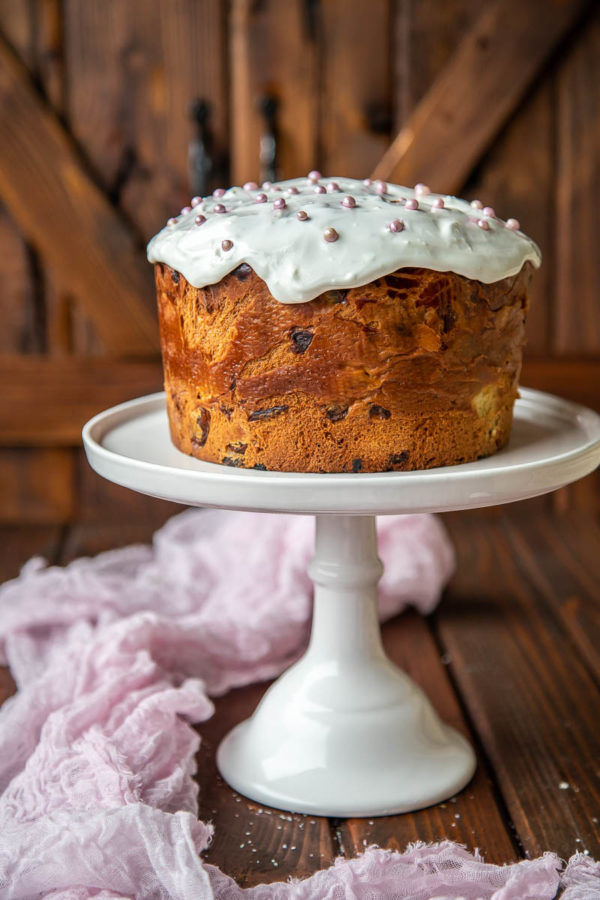
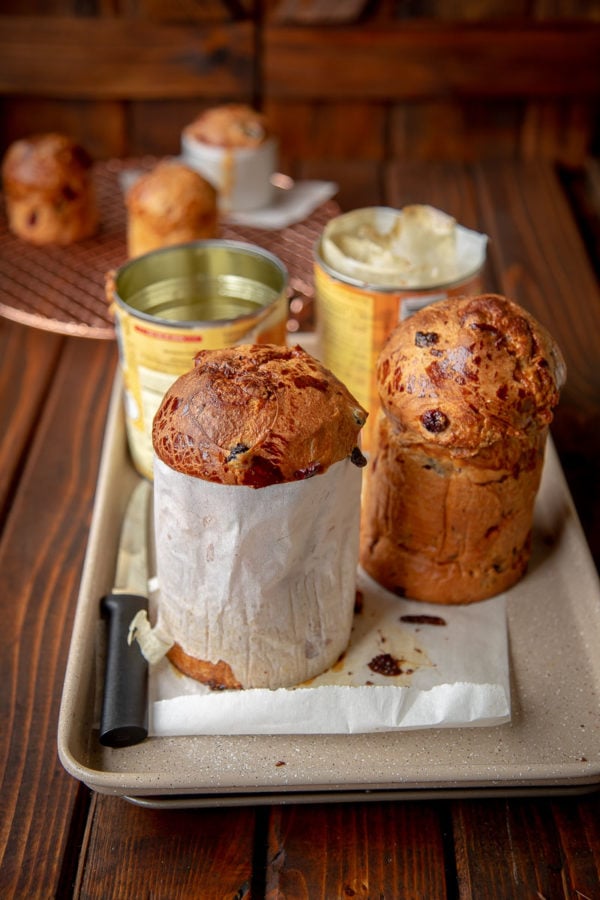
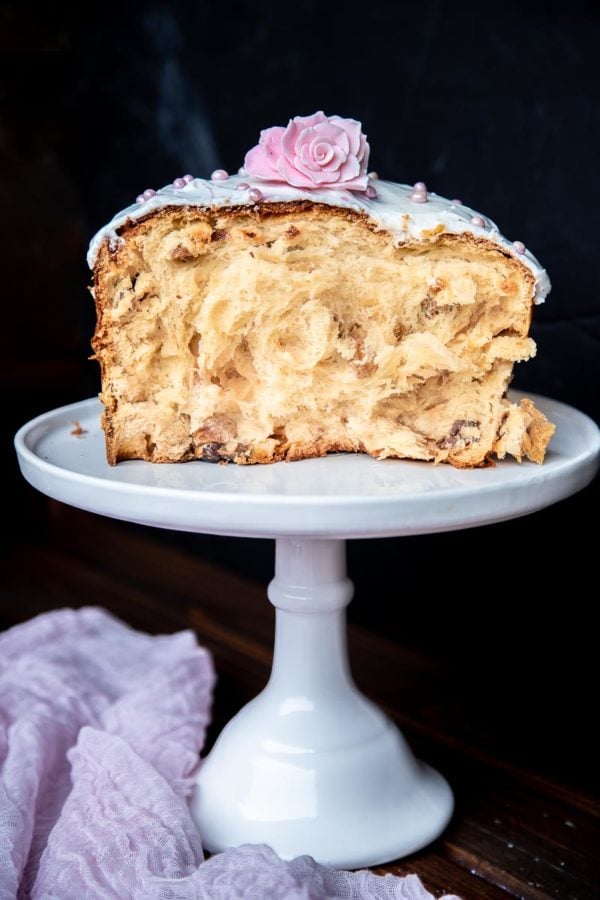

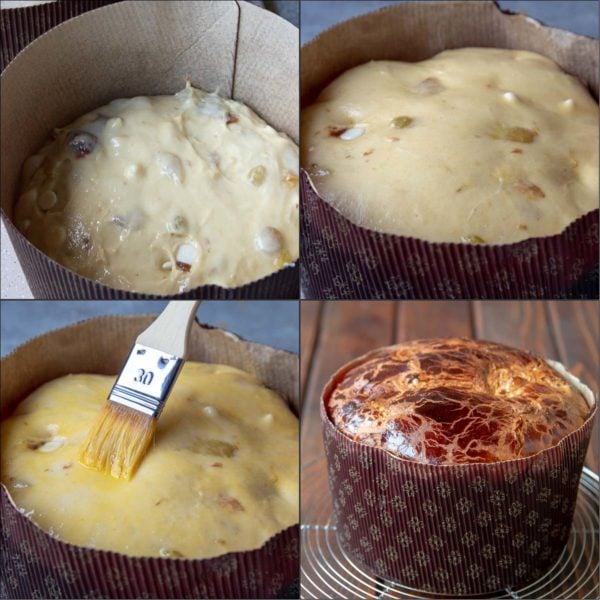
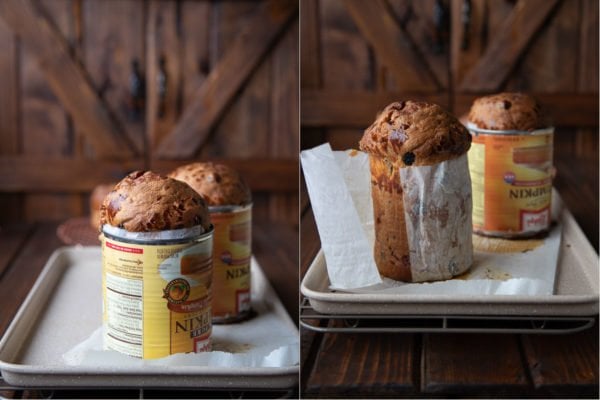
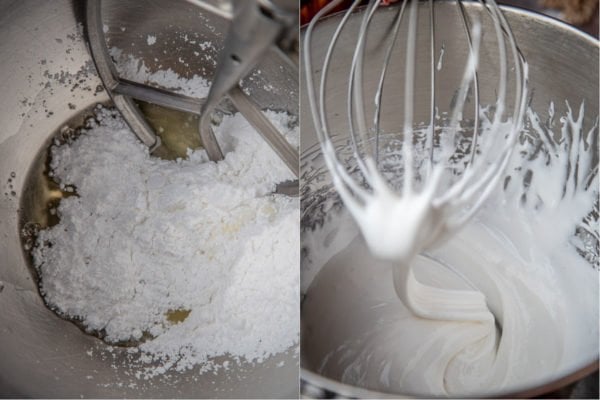
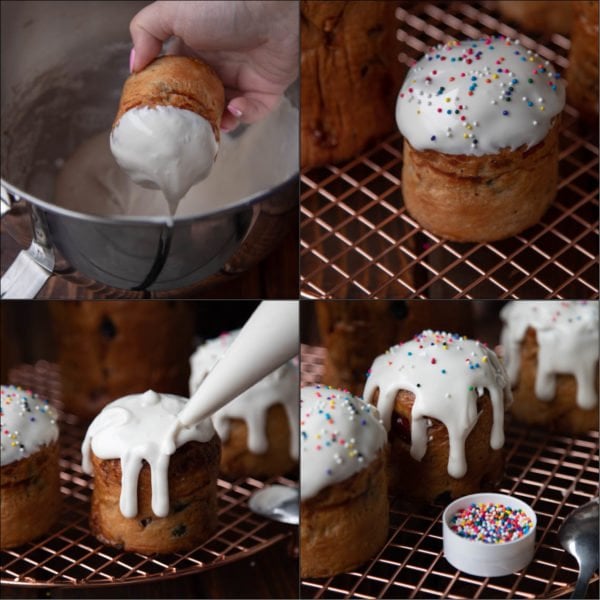
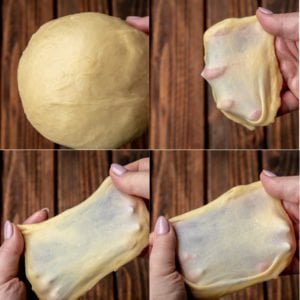
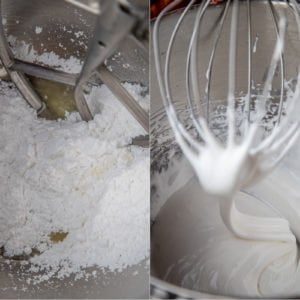



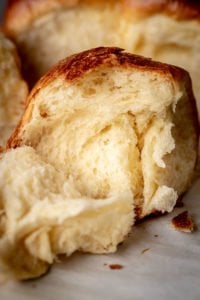
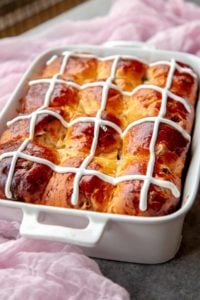
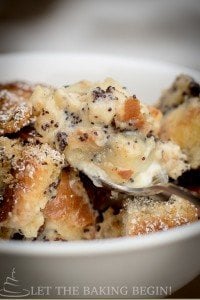
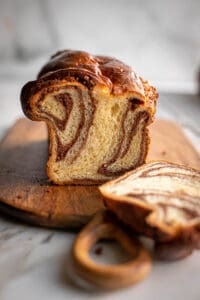
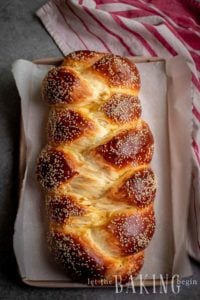

Hello 🙂
How should this be stored? I’m assuming in the fridge with the frosting…but if I didn’t put it on could I leave them at room temp for a couple days?
Thanks so much!
You store it at room temp since the amount of sugar serves as a preservative in the icing.
Can you bake this in a 9 inch springform pan?
Yes, it will just be a bit more flat.
Do you usually bake these the day before or on Easter morning? I’m concerned that the bread could get a little dry if I leave it out overnight (I don’t own a cake dome) but am also afraid I may not have sufficient time to cool it before glazing if I’m proofing and baking the morning of…
I baked mine 2 days ahead and it was still perfect. This bread is mostly butter and butter will keep the bread soft for awhile. Just keep it wrapped or under a dome so it doesn’t dry out.
I love mine microwaved for about 10 seconds to bring out the butteriness and make it even softer.
Thank you for the best recipe for paskha! I’ve made
it for the past several years.
That’s amazing! Thank you for sharing!
Hey I wanted to try the recipe but wanted to ask why when I change into Metric system the amount of eggs changes to 185 large eggs but if it’s the US Customary it’s only 4 large eggs ? Thank you
Hi Dani,
it’s supposed to have “g” next to it, not sure why it’s glitching.
I have actually done several more batches to test this recipe out and found that larger sized large eggs make better Easter bread so I changed the amount to 200 grams. It shows up with a “g” next to it now 🙂
Wonderful recipe Marina thanks for sharing. I was excited to try it I ordered the paper molds and got them in time to make. In 3 1/2 in paper molds I made 6.
I used orange juice in icing from the ones zested for recipe. The house smelled amazing during the baking. Fluffy and slightly sweet delicious bread. Made a fantastic centerpiece for my Easter lunch. If you can Marina can you update the times at the top of recipe to reflect the rising times. I did mine without overnight or refrigerator step and it was so good. Will definitely make again
Hi. I looking forward to trying this recipe. I bake artisan Panettone and will use some starter with the yeast when I try this. My question is- would it be a good idea to hang these upside down when they come out if the oven like we do with Panettone? Do they collapse at all? It looks wonderful! Thanks for sharing your time and recipe!!
Hi Cindy,
yes, hanging them upside down is a great idea! I do that sometimes (when I remember) and it definitely keeps the texture from collapsing. The pictured ones in the post were not hung upside down (for reference).
Wow these came out amazingggggg!!! I need tot ake some with is tomorrow for our Easter celebration but I’m really debating if I should just eat them all right now!
I know the feeling, Elise lol.
Hoe you had a great Easter!
About how long do you find the second proof takes when you make in the small 2 inch round?
Hi Meg, it really depends on the temperature in which you’re proofing. In 90F temperature the dough rises rather fast (1-2 hours) but anything lower than that can take significantly lower than that. Sometimes if I leave the dough at 66F (room temperature for us) it can take up to 10 hours, so I just start my recipe in the morning to accommodate for the time.
Hi Marina. I decided to start early and baked this Paska this morning. I do want to let you know right away that I did one modification. I cut down the active yeast to about 1 tsp and added about 150grams of sourdough starter. Oh wow! The flavor and texture was spot on. So soft, tender and delicious. Not too sweet, just perfect. Everything from start to finish went smooth (I made the dough last night), the dough was loose at first but that didn’t worry me, it all came together after 15 mins of mixing in the kitchen aid. I also did the windowpane test and it quite surprised me, I was able to stretch out a pretty decent rectangle without tearing. Thank you again. So so so good. I can’t stop eating it
Messages like yours totally make my day! This is an advanced level recipe so when it works out for others, it makes me so happy! Happy Easter!
I love the addition of sourdough! I too, made this year’s Paska dough with sourdough starter, but I used some of the discard instead of the actual active starter and didn’t adjust the amount of yeast and I love the result as well!
Could you substitute buttermilk for the milk/water?
Hi Ashley, I haven’t done it so can’t tell you if it will work 🙁
One more question! If I need to bake several different sizes, can I still bake them all at once in the oven? Like a large one and small ones together, and just pull out the smaller ones first? Or is it best to bake them one at a time?
Yes, you can pull the smaller ones sooner. I’ve done that and it turned out fine .Just make sure to put the smaller ones closer to the oven door so you don’t have to wiggle the larger ones too much.
Excited to try this for Easter! So if I enters them done by Saturday, I could start on Thursday, refrigerate it and then bake on Saturday, correct?
Yep! that sounds like a good schedule.
Marina, you are a genius! I have been looking for the right Paska recipe forever, and this one is perfect! It tastes just like back home 🙂 And all the tips and suggestions are amazing, they were super helpful through the process! Thank you so much!!!
I followed all the instructions, but my dough doesn’t look like yours in the bread machine….it’s more liquidy than firm. Please help!!!!
add a little more flour at a time until it starts to come together, then keep kneading.
1/4 – 1/2 cup?
I never heard about cutting the bottom of the can when baking and decided to try it this time, it was a disaster, the dough literally lifted the cans and all my kulichi collapsed. I would not do this ever again.
Sounds like your dough was under-proofed so when it hit the hot temps, the burst of heat just raised the can.
Thank you so much for ur hard work. Those are so yummy. I’m making triple recepie this year
Thank you so muchfor ur hard work. Those are so yummy. I’m making triple recepie this year
Hello! Thank you so much for sharing your recipe. I was wondering if I could use this recipe to make kulich cruffins? If yes how much butter do you think I’d need to laminate the dough?
Hi Farhana,
I haven’t tried it, so can not tell you if it will work.
But here are my thoughts.
This dough is very delicate and airy. If you laminate the dough with the butter, the layers between the butter might collapse when you take it out of the oven.
To avoid it I would make the dough without the butter and increase the flour by about 3/4th cup, then use the butter in the recipe to laminate the dough. I would sprinkle the dried fruits between the layers as you laminate with butter.
If you do try it, let me know how it goes!
Marina, you are the best out of all Russian bloggers!!!
Thank you for this beautiful Paska recipe,
all tips and step by step directions which are really easy to follow!!!
Paska came out fluffy, airy and very tasty!
Made mini & tall ones using kitchen aid stand mixer!
Would never be able to mix dough for 40mins by hand
Only thing I added 4 tbsp of vanilla extract and it was not too much just perfect
From now on will only use this recipe❤️
Thank you Marina for your hard work and beautiful pictures!
God Bless your Family and Happy Easter!
Diana, you’re too kind! Thank you so, so much! I really appreciate your feedback and kind words. Makes me really happy that you’ve enjoyed this recipe.
May God bless your family too!
Hi Marina!!
I’m wanting to make this recipe for the first time this easter but don’t have a bread maker/ stand mixer! I only have a thermomix but doubt that would be adequate due to the blades. Am I able to do this by hand? If so, how do you suggest going about it?
Thanks so much, can’t wait to try!
Hi Angela,
I wouldn’t try it in the thermomix because it would cut through gluten strands instead of promoting their development. To be honest, I’m not sure what I would do. You could add 1/2 a cup more flour and attempt to knead it by hand.
Hello, if I want to make two batches of the Easter bread do I do it in two separate batches or can I combine into one batch?
I would mix them together.
Hi! So I’m doing the Easter bread in the kitchen aid and it’s been mixing for over an hour and it’s still on runny side and sticky! Should I add more flour?
Go ahead and add a little more flour (may be up to 1/2 cup?). If it doesn’t come together to look like mine, just leave it as is and let it proof. Most likely your flour has very low gluten content and that why it looks like that. It will be fine in the end product though.
Great recipe! I was scared to try it but went ahead anyway. It turned out so so yummy. The inside was so soft and delicious!
Hi , so when do we add in the salt?
With the butter
Hi Marina. After taking it out of the fridge and shaping it does it need to stand and proof again?
Thank you
Hi Inna,
Yes it does. Remove from the fridge, shape, allow to proof and double in size, then bake.
Hi Marina,
Do I still let the dough rise for 1 hour before putting in refrigerator for 4 hours to chill? And after taking it out how long do you let it rise for again?
Yes, you let it rise until almost doubled in size. then place in the fridge for a couple hours (up to 48 hrs). Then remove from the oven, shape it and put in the mold to double in size (in the preheated for 2-3 minutes oven at 200F, where the temp should be no higher than 100F). It can take anywhere from 1.5 hours to 3 hours.
Oh, wow!!! Thank you so much for sharing the recipe! It looks so delicious and sweet!
Thank you so much for your comment Andrew!
Can I double or triple the recipe?
Yes, easily.
You can slide the arrow up by the servings until it’s double, and the ingredients in the recipe will double as well, for an easy printable recipe 🙂
Can this beautiful bread be baked in a loaf pan? If so, what size? I do not have time to get the paper molds before baking for Easter. Thanks
Hi Karen,
Yes, you can easily make it in a loaf pan. I would split it between two loaf pans though, just so that it doesn’t overflow.